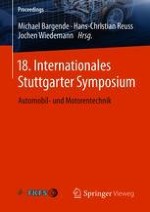2018 | OriginalPaper | Buchkapitel
Alignment of simulation methodology and measurement techniques to predict the HC distribution at catalyst inlet
verfasst von : Verena Huth, A. Dhongde, D. Klein, M. Günther, S. Pischinger, T. Fukuma
Erschienen in: 18. Internationales Stuttgarter Symposium
Verlag: Springer Fachmedien Wiesbaden
Aktivieren Sie unsere intelligente Suche, um passende Fachinhalte oder Patente zu finden.
Wählen Sie Textabschnitte aus um mit Künstlicher Intelligenz passenden Patente zu finden. powered by
Markieren Sie Textabschnitte, um KI-gestützt weitere passende Inhalte zu finden. powered by
Injection of fuel into the exhaust system is increasingly being used to support the operation of exhaust gas aftertreatment systems. When injecting a fluid into the exhaust system, one major challenge is to define an optimum position of the injector and its spray hole configuration along with an appropriate injection pressure. Simulation techniques are a suitable means to support the corresponding development process. Hence, the project “Exhaust Fuel Injection” was initiated. Project target is the alignment of simulation methods and measurement techniques to predict the HC distribution in radial and axial direction at the inlet of a catalyst. This includes the development of suitable measurement techniques to determine the hydrocarbon concentrations upstream and downstream of a catalyst.Transient 3D Computational Fluid Dynamics (CFD) simulation was used to model the fuel injection into a purpose-built exhaust system. The simulation results of the distribution of hydrocarbons at catalyst inlet in radial and axial direction are compared with measurements performed at an engine test bench. The measurements include optical techniques using Mie-scattering to determine whether droplets occur or not and Laser- Induced Liquid Fluorescence (LIF) measurements, where a tracer indicates the HC concentration in the gas phase. Additionally, the HC-concentration was measured using an HC exhaust gas analyzer (Fast FID).A total of 21 parameter variations were simulated and measured showing high comparability with the measurements (deviation below 2 %) regarding the uniformity index (radial uniformity) as well as peak gradient and duration (axial uniformity) in 13 variations. Only four of the 21 simulated cases showed poorer conformity (deviation above 3 %). Especially simulations in operating points with comparably low exhaust temperatures (340 °C – 395 °C) matched well. Also, the influence of different injection pressures (5-50 bar) was modeled with good accuracy. Highest deviations between simulation and measurement were found with high exhaust temperatures and low exhaust mass flow rates and in the variations with mixers.
